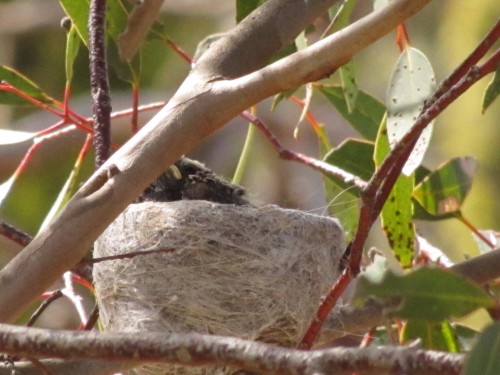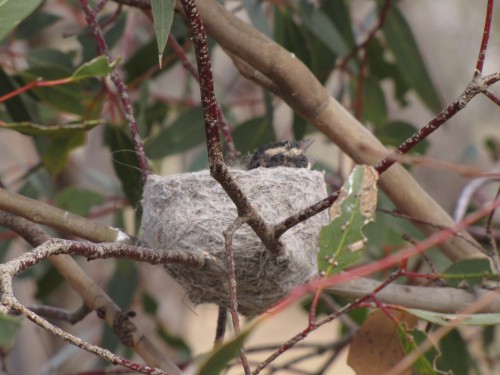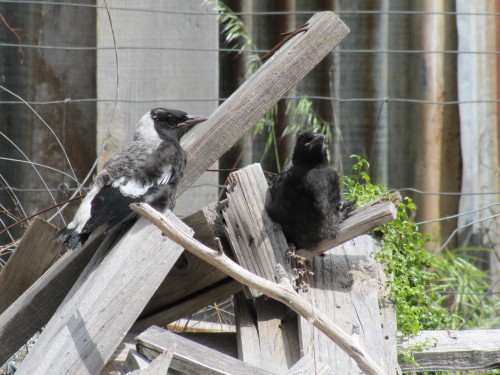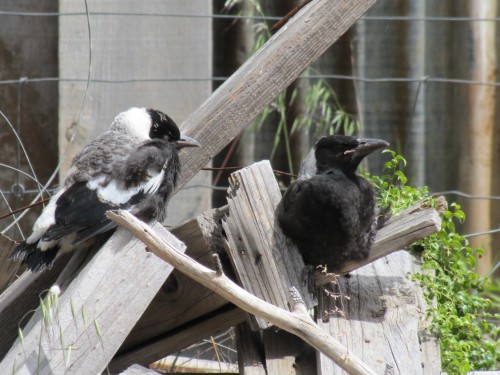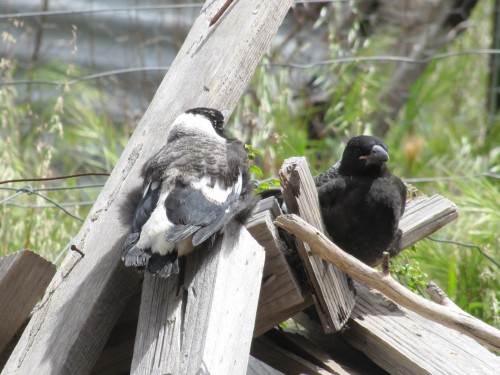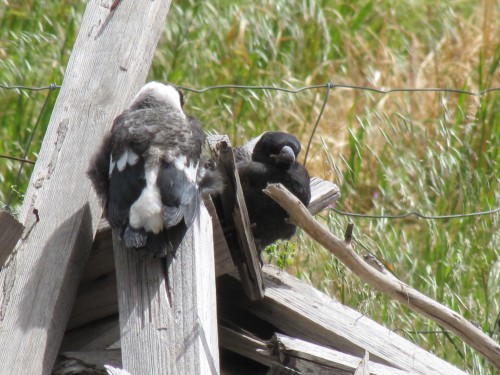Baby birds everywhere
Over the past month or so the area around our garden has been full of birds nesting, sitting on eggs, feeding young or busy feeding the fledglings after they leave their nest. Spring time here in South Australia is the main breeding season for many species of birds, especially the bush birds. Many of our trees and shrubs are also flowering which means plenty of food for the birds, both the nectivorous and insectivorous species.
Here is an annotated list of the species I have observed nesting or feeding young this spring, plus a few species I suspect have been nesting nearby. All of these observations have been in our garden or on our 5 acre property in Murray Bridge, South Australia.
- Willie Wagtail – the photos of the nest (above and below) on today’s post are of the nest with two babies just peeping over the top of the beautiful cobweb lined nest. They have since fledged and are flying around begging for food.
- Australian Magpie – I knew that our resident magpies were nesting but it was only when the young started calling to be fed that I found the nest. They had made a nest in a completely new tree this year. Last year’s nest tree was blown over by one of our winter storms. (Must cut it up for firewood.)
- House Sparrow – these seem to be always nesting, not just in the spring.
- Common Starling – about a dozen tree hollows had nests in them and it is quite obvious when there are babies in the nest; their calling for food is incessant. Most of the starlings have now flown off to the fruit growing districts nearby.
- Red Wattlebird – there have been several fledged young wattlebirds getting around in recent weeks. I suspect that the adults may well be nesting again. The male continues to boss all the other smaller species quite unmercifully. They don’t like sharing their food, even though there is plenty to go around.
- New Holland Honeyeater – I saw several parents feeding young just out of the nest quite a few weeks ago. They may well be nesting again, but their nests are usually well hidden in dense bushes.
- Peaceful Dove – we saw a pair mating and they have been hanging around close to the house for many weeks. I have yet to find the nest – in part due to a very bad back at present.
- Crested Pigeon – this species always seems to be breeding, but they chose a bush quite a distance from the house this spring.
- Spotted Turtledove – again, due to my back I haven’t yet found their nest.
- Galahs – this one is tragic. After many attempts at breeding over several years in a tree hollow near the house they finally hatched a brood of young, only to see them die in the nest during an unseasonably hot spell several weeks ago.
- Common Blackbird – this species often makes a nest in our garden shed, but this year they seem to be nesting next door and only visit our garden occasionally.
- Australian Magpie-Lark – again, this species has chosen to nest in the neighbour’s tall trees. They visit our garden frequently to catch food for the young.
- White-winged Chough – another species which visits frequently – except in recent weeks. I often see them down the road about a hundred metres away, so they are probably nesting there.
- Little Ravens – although several of this species visit almost daily, I have yet to record them nesting in one of our trees, preferring to keep away from the magpies’ nest, I presume.
- White-browed Babblers – it has been quite a few years since they last nested in our garden but they are regular visitors – except in recent weeks – they must be nesting somewhere nearby.
- Superb Fairy-wren – our resident pair still seems to be around the house garden, but they are very quiet and secretive about the location of their nest.
- Cuckoos – we have heard the calls of the Horsfield’s Bronze-cuckoo a few times several weeks ago but have seen no evidence that they stayed long enough to nest.
- Other possibilities: White-plumed honeyeater, Singing Honeyeater, Spiny-cheeked Honeyeater, Yellow-rumped Thornbill, Weebill, Striated Pardalote, Spotted Pardalote.
Wild weather and baby magpies
Over the last few weeks we have had some violent wind storms. Spring here in South Australia can often be windy, but these were gale force winds. One afternoon earlier this week wind gusts up to 80kph were recorded many times. While we didn’t suffer any property damage others in our state were not as fortunate. One poor man even drowned when his boat was overturned in rough conditions on the River Murray upstream from my home town of Murray Bridge.
During the worst of the stormy weather I was concerned for the baby magpies in two nests within 50 metres of my office where I am writing this post. We had watched with interest when the nests were being built. Actually, they were last year’s nests which were refurbished. Then we waited while the mother birds sat patiently during the incubation period. Then over the last few weeks there was a constant begging noise from the babies.
When the first storm hit last Monday the babies were able to hang on to the nesting material. The following storms on Wednesday were even worse and the young were blown out of their cosy homes. Watching them today I suspect that they were not yet quite ready to fledge* because they are still unable to fly; they run everywhere – well, it’s more of a wobbly, unsteady waddle.
At one point the two babies from the nest closest to our house clambered up on a heap of scrap wood near the garage. I managed to get up reasonably close without spooking them, thus getting some good photos. You will notice that they are still very downy. These downy feathers will remain for some months yet. You will also notice that the nearest one has not much of a tail yet. In the first few days after fledging, they are terrible flyers as they learn how to get around; having virtually no tail does not help.
*Note: to see a definition of the word fledge click here.
Further reading:
- Baby Magpie – the most popular post on this site with nearly 500 comments from readers.
- Crash landing for a baby magpie
Have the babies flown the nest?
We have a pair of Willie Wagtails who live in our garden. They often come very close to us as we work in the garden, especially when we are weeding or digging the garden beds. They are quite unafraid of us. Every year they build a nest somewhere near the house. Quite often they will even have a second brood of young ones.
This year I noticed them building a nest a few days before we went to Sydney for just over two weeks. I checked on our return and one of the adults was sitting on the nest; I didn’t know if there were eggs or chicks in the nest and didn’t want to disturb the parent bird. Now two weeks later and the nest is empty – in fact, it’s on the ground.
Enough time has elapsed for the eggs to have hatched and the young to have flown. Strange then that we haven’t seen the little ones begging to be fed. I suspect that the nest may have been raided by some form of predator: raven, magpie, currawong, falcon – even a stray cat that has been lurking in the vicinity.
All I can hope is that they decide to nest again – in a more secure location.
We have baby Willie Wagtails in a nest
I had suspected that our resident pair of Willie Wagtails have been nesting somewhere in our mallee scrub but hadn’t been able to locate the nest. They can be very sneaky and secretive about the whole affair.
Then a few days ago I was cleaning up in an area of the scrub not frequented all that often and I was attacked by the adults. Not that they actually hit or bit me; they just made it quite obvious by their scotching calls and close swooping over my head that I was not welcome.
Sure enough – three fluffy chicks were over filling a totally inadequate nest. The photo above shows their home almost bursting at the seams.
I took the photo a few weeks ago and the chicks have now fledged and are making their presence known around the garden, demanding food from a harried set of parents struggling to keep up with their insistent calling for food.
The next question is: will the parents nest again once this brood is off their hands… er… beaks and feeding themselves independently?
The photo of some fledged Willie Wagtails was taken a few years ago at the same location.
Further reading:
Crash landing for a baby magpie
Over recent weeks we have been eagerly awaiting the hatching of the baby Australian magpies in two nests in our garden. The fact that we have two nests is exciting because this is the first time in the last 25 years we’ve had two active nests on our 5 acre property.
A few weeks ago we heard the constant squawking of the young for food, so we knew it was just a matter of time before the youngsters headed out into the wild world. Several days ago I was suddenly aroused from my concentration on my writing by a bang on the window no more than a metre from my shoulder. A baby magpie – fresh out of the nest – was perched precariously on the frame of the window. When I reached for my camera it flew off to another part of the garden. When I say “flew” I actually mean it was undertaking some sort of barely controlled flapping and squawking one could loosely call “flying”.
I was able to approach the baby to within two metres with dad right next to me – quite unconcerned. I find it wonderful that they never swoop us or get concerned by our presence nearby. In fact, they will often approach us when we are gardening, looking for worms and other tasty morsels we might dig up. Wonderful.
